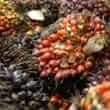Background
- Palm oil is an edible vegetable oil derived from the fruit of the oil palm tree (Elaeis guineensis). Crude or virgin palm oil is called "red palm oil" because of its characteristic dark red color due to the high beta-carotene content. Boiling destroys the carotenoids, causing the oil to lose its color. Two different types of oils may be extracted from the oil palm tree. Palm oil is derived from the fleshy portion of the palm fruit, while palm kernel oil is derived from the seed or the kernel. Palm oil contains mainly palmitic and oleic acids and is about 50% saturated, while palm kernel oil contains mainly lauric acid and is more than 89% saturated. Palm kernel oil does not convey as many health benefits as palm oil due to its higher levels of saturated fat.
- Palm oil has an important role in the diet and the economies of Asia, Africa, and Latin America. It is estimated that 90% of palm oil produced is used in foods such as margarine, shortening, and mayonnaise. It is commonly used as a cooking and frying oil, although there is evidence that its health benefits are lost during excessive heating or frying. Palm oil is also found in soaps, washing powders, cosmetics, and biodiesel. It is popular in processed foods, because it does not contain cholesterol and requires little or no hydrogenation, a process that produces trans-fatty acids. Many food manufacturers are using palm oil in place of hydrogenated oils in their products and then advertising them as being "trans fat and cholesterol free." However, many people consider palm oil to be unhealthy due to its high saturated fatty acid content.
- Palm oil is a rich source of antioxidants, including vitamin E (tocopherols and tocotrienols), carotenoids (beta-carotene, lycopene), and coenzyme Q10 and has been proposed as an alternative treatment of vitamin A deficiency for several reasons. Palm oil has been reported to have highly bioconvertible forms of alpha- and beta-carotene and to enhance the bioavailability of beta-carotene. It has also been reported to have a long shelf life and a higher cost-benefit ratio when compared to alternative treatments of vitamin A deficiency, like high-dose vitamin A supplements and the addition of retinyl ester fortificants to food. Supplementation of red palm oil as a capsule or a food fortificant may be effective against malnutrition.
- Clinical trials have shown that palm oil is effective at treating and preventing vitamin A deficiency. Studies have also been performed to examine the benefits of using palm oil to prevent or treat heart disease, breast inflammation (following childbirth), diarrhea, high cholesterol, and obesity. However, at this time, high-quality human research supporting the use of palm oil for these or other indications are lacking.
References
- Bosch V, Aular A, Medina J, et al. [Changes in of plasma lipoproteins after the use of palm oil in the diet of a group healthy adults]. Arch Latinoam Nutr 2002;52(2):145-150. View Abstract
- Canfield LM, Kaminsky RG, Taren DL, et al. Red palm oil in the maternal diet increases provitamin A carotenoids in breastmilk and serum of the mother-infant dyad. Eur J Nutr 2001;40(1):30-38. View Abstract
- Grange AO, Santosham M, Ayodele AK, et al. Evaluation of a maize-cowpea-palm oil diet for the dietary management of Nigerian children with acute, watery diarrhea. Acta Paediatr. 1994;83(8):825-832. View Abstract
- Jackson KG, Robertson MD, Fielding BA, et al. Measurement of apolipoprotein B-48 in the Svedberg flotation rate (S(f))>400, S(f) 60-400 and S(f) 20-60 lipoprotein fractions reveals novel findings with respect to the effects of dietary fatty acids on triacylglycerol-rich lipoproteins in postmenopausal women. Clin Sci (Lond) 2002;103(3):227-237. View Abstract
- Ladeia AM, Costa-Matos E, Barata-Passos R, et al. A palm oil-rich diet may reduce serum lipids in healthy young individuals. Nutrition 2008;24(1):11-15. View Abstract
- Lietz G, Henry CJ, Mulokozi G, et al. Comparison of the effects of supplemental red palm oil and sunflower oil on maternal vitamin A status. Am.J Clin.Nutr. 2001;74(4):501-509. View Abstract
- Sivan YS, Jayakumar YA, Arumughan C, et al. Impact of beta-carotene supplementation through red palm. J Trop.Pediatr 2001;47(2):67-72. View Abstract
- Utarwuthipong T, Komindr S, Pakpeankitvatana V, et al. Small dense low-density lipoprotein concentration and oxidative susceptibility changes after consumption of soybean oil, rice bran oil, palm oil and mixed rice bran/palm oil in hypercholesterolaemic women. J Int Med Res 2009;37(1):96-104. View Abstract
- van Stuijvenberg ME, Dhansay MA, Lombard CJ, et al. The effect of a biscuit with red palm oil as a source of beta-carotene on the vitamin A status of primary school children: a comparison with beta-carotene from a synthetic source in a randomised controlled trial. Eur J Clin Nutr 2001;55(8):657-662. View Abstract
- van Stuijvenberg ME, Faber M, Dhansay MA, et al. Red palm oil as a source of beta-carotene in a school biscuit used to address vitamin A deficiency in primary school children. Int J Food Sci Nutr 2000;51 Suppl:S43-S50. View Abstract
- van Rooyen J, Esterhuyse AJ, Engelbrecht AM et al. Health benefits of a natural carotenoid rich oil: a proposed mechanism of protection against ischaemia/ reperfusion injury. Asia Pac J Clin Nutr 2008;17 Suppl 1:316-319. View Abstract
- Yli-Jokipii KM, Schwab US, Tahvonen RL, et al. Triacylglycerol molecular weight and to a lesser extent, fatty acid positional distribution, affect chylomicron triacylglycerol composition in women. J Nutr 2002;132(5):924-929. View Abstract
- Zagre NM, Delpeuch F, Traissac P, et al. Red palm oil as a source of vitamin A for mothers and children: impact of a pilot project in Burkina Faso. Public Health Nutr. 2003;6(8):733-742. View Abstract
- Zhang J, Ping W, Chunrong W, et al. Nonhypercholesterolemic effects of a palm oil diet in Chinese adults. J Nutr 1997;127(3):509S-513S. View Abstract
- Zock PL, de Vries JH, Katan MB. Impact of myristic acid versus palmitic acid on serum lipid and lipoprotein levels in healthy women and men. Arterioscler Thromb 1994;14(4):567-575. View Abstract







